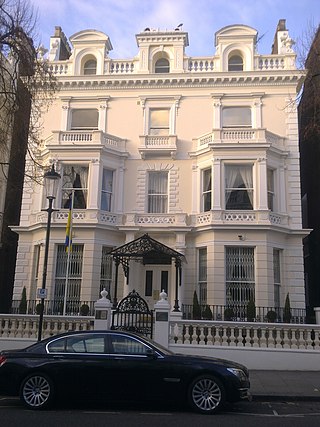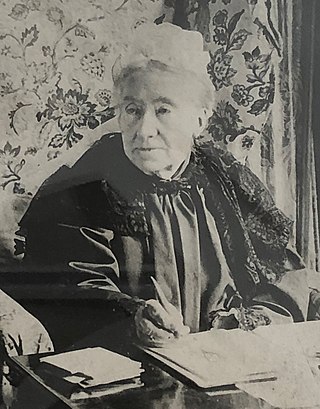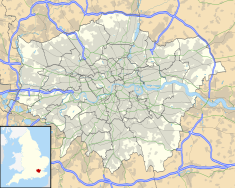
Kensington is an area of London in the Royal Borough of Kensington and Chelsea, around 2.9 miles (4.6 km) west of Central London.

Notting Hill is a district of West London, England, in the Royal Borough of Kensington and Chelsea. Notting Hill is known for being a cosmopolitan and multicultural neighbourhood, hosting the annual Notting Hill Carnival and the Portobello Road Market. From around 1870, Notting Hill had an association with artists.

Moncure Daniel Conway was an American abolitionist minister and radical writer. At various times Methodist, Unitarian, and a Freethinker, he descended from patriotic and patrician families of Virginia and Maryland but spent most of the final four decades of his life abroad in England and France, where he wrote biographies of Edmund Randolph, Nathaniel Hawthorne and Thomas Paine and his own autobiography. He led freethinkers in London's South Place Chapel, now Conway Hall.

Holland Park is an area of Kensington, on the western edge of Central London, that lies within the Royal Borough of Kensington and Chelsea and largely surrounds its namesake park, Holland Park.

Kensington Palace Gardens is an exclusive street in Kensington, west of central London, near Kensington Gardens and Kensington Palace. Entered through gates at either end and guarded by sentry boxes, it was the location of the London Cage, the British government MI19 centre used during the Second World War and the Cold War. Several foreign diplomatic missions are located along it.

Gloucester Road is a street in the Royal Borough of Kensington and Chelsea, London. It runs north–south between Kensington Gardens and Old Brompton Road.

West Kensington, formerly North End, is an area in the ancient parish of Fulham, in the London Borough of Hammersmith and Fulham, England, 3.4 miles (5.5 km) west of Charing Cross. It covers most of the London postal area of W14, including the area around Barons Court tube station, and is defined as the area between Lillie Road and Hammersmith Road to the west, Fulham Palace Road to the south, Hammersmith to the north and West Brompton and Earl's Court to the east. The area is bisected by the major London artery the A4, locally known as the Talgarth Road. Its main local thoroughfare is the North End Road.

Peter Alfred Taylor was a British politician, anti-vaccinationist and radical.

Campden Hill is a hill in Kensington, West London, bounded by Holland Park Avenue on the north, Kensington High Street on the south, Kensington Palace Gardens on the east and Abbotsbury Road on the west. The name derives from the former Campden House, built by Baptist Hicks, 1st Viscount Campden whose country seat was Campden House in the Gloucestershire town of Chipping Campden.

Pinehurst Court is a portered Victorian mansion block at 1-9 Colville Gardens, just off Colville Terrace and near the Portobello Market in Notting Hill, London, England. The terrace was initially built in the 1870s by the builder George Frederick Tippett, as single family residences, but from the 1880s the houses began to be subdivided into flats. By 1928 the neighbourhood was described as "rapidly becoming poorer", and by 1935 as a "largely slum area". The gentrification of Notting Hill in the 1980s and 1980s greatly improved the character of the building, which now forms a part of one of London's most fashionable neighbourhoods.

St John's Notting Hill is a Victorian Anglican church built in 1845 in Lansdowne Crescent, Notting Hill, London, designed by the architects John Hargrave Stevens (1805/6–1857) and George Alexander (1810–1885), and built in the Victorian Gothic style. Dedicated to St John the Evangelist, the church was originally built as the centrepiece of the Ladbroke Estate, a mid nineteenth century housing development designed to attract upper- and upper middle-class residents to what was then a largely rural neighbourhood in the western suburbs of London.
The Kensington Proprietary Grammar School, colloquially referred to as the Kensington School, was an educational establishment founded in 1830 that is perhaps best remembered for being one of the founders of the Football Association in 1863.

Essex Street Chapel, also known as Essex Church, is a Unitarian place of worship in London. It was the first church in England set up with this doctrine, and was established when Dissenters still faced legal threat. As the birthplace of British Unitarianism, Essex Street has particularly been associated with social reformers and theologians. The congregation moved west in the 19th century, allowing the building to be turned into the headquarters for the British and Foreign Unitarian Association and the Sunday School Association. These evolved into the General Assembly of Unitarian and Free Christian Churches, the umbrella organisation for British Unitarianism, which is still based on the same site, in an office building called Essex Hall. This article deals with the buildings, the history, and the current church, based in Kensington.

Clementia Taylor was an English women's rights activist and radical.

Caroline Ashurst Stansfeld was a member of an important family of radical activists in mid-nineteenth-century England who supported causes ranging from women's suffrage to Italian unification. In 1844, she married Sir James Stansfeld (1820–1898), the future MP for Halifax and preeminent political advocate for the movement to repeal the Contagious Diseases Acts. She maintained a close friendship with Italian nationalist Giuseppe Mazzini, who wrote to her frequently and 1,500 of his letters to the family have been published in E.F. Richards’ collection: Letters to an English Family.

The Ladies' London Emancipation Society was an activist abolitionist group founded in 1863, which disseminated anti-slavery material to advance British understanding of the Union cause in the American Civil War as one pertaining to morality rather than territory. This was said to be the first national anti-slavery society for women.
Charlotte Manning was a British feminist, scholar and writer. She was the first head of Girton College.

Elizabeth Malleson was an English educationalist, suffragist and activist for women's education and rural nursing.
Rachel Frances Alexander was a social campaigner in Kensington, London. She was involved in the foundation of several charities in the borough including, the Kensington Housing Trust, the Kensington Council of Social Service and the North Kensington Community Centre. Her father William Cleverly Alexander was an early supporter of the painter James McNeill Whistler, who painted two of her elder sisters. Rachel herself was painted by the artist William Nicholson and she and her younger sister Jean donated seventeen paintings from their father's art collection to the National Gallery and pieces of his Japanese collection to the Victoria and Albert.


















